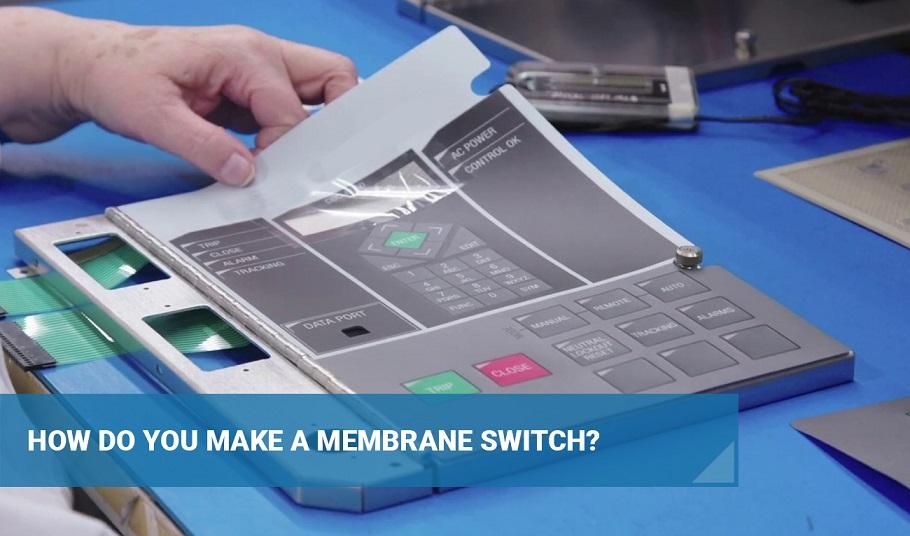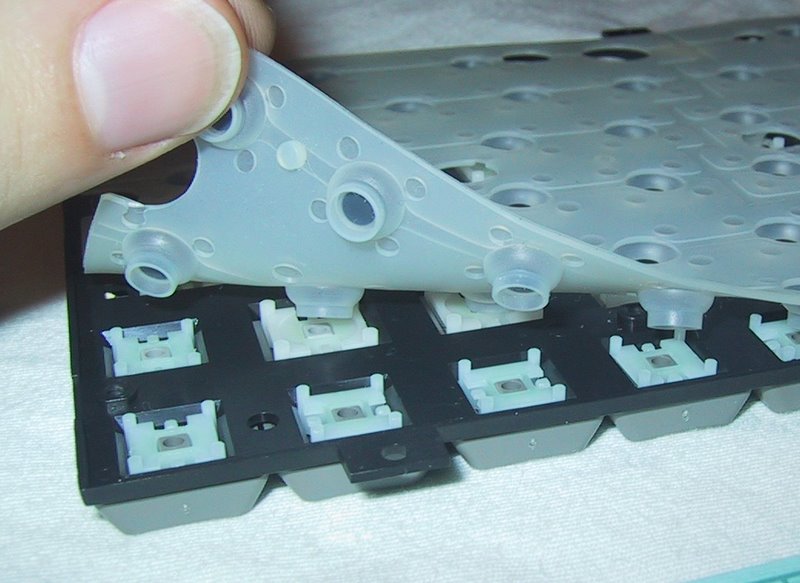Tailored Designs by a Expert Membrane Switch Manufacturer
Tailored Designs by a Expert Membrane Switch Manufacturer
Blog Article
How Membrane Switch Technology Works and Its Function in Interface Layout
Membrane button modern technology is an innovative method that incorporates layered materials for touch-sensitive input. When pushed, its design consists of visuals overlays, conductive layers, and adhesive parts that connect. This interaction not only completes an electric circuit however also influences the general user experience. Comprehending the intricacies of this technology exposes its substantial effect on interface style, provoking questions regarding its applications and future growths in various markets.
Recognizing Membrane Switch Modern Technology
Membrane button technology functions as a pivotal part in contemporary customer interface design. This innovation combines graphic overlays, touch-sensitive membrane layers, and circuit layers to develop a small, dependable input method for various gadgets. The style normally contains multiple layers, consisting of a published visuals layer that permits individuals to communicate with the tool via tactile responses. Membrane buttons are understood for their longevity, resistance to moisture, and ease of cleaning, making them suitable for atmospheres where traditional mechanical switches may stop working. Their low-profile layout enables seamless combination into devices, contributing to a streamlined appearance. On top of that, Membrane switches can be personalized with different shades, textures, and signs, improving customer experience and aesthetic appeal. This flexibility makes them preferred in consumer electronics, medical tools, and industrial controls, where intuitive interaction is essential. Generally, Membrane button technology represents a significant innovation in how individuals engage with digital user interfaces.
Key Components of Membrane Switches
Membrane switches contain several essential parts that add to their performance and layout. The conductive layer products, adhesive and assistance layers, and visuals overlay layout each play an important function in making sure suitable efficiency and individual communication. Comprehending these components is crucial for reliable interface design.
Conductive Layer Materials
Conductive layer products play a vital duty in the functionality and reliability of Membrane buttons. When pressure is used to the switch, these products are liable for finishing electrical circuits. Generally, a mix of conductive inks, such as silver or carbon, is utilized to develop these layers. Silver conductive ink is preferred for its superior conductivity and toughness, while carbon ink is typically used for cost-efficient applications. The selection of product impacts not only the electrical performance but also the total lifespan of the button. Furthermore, the thickness and composition of conductive layers can influence responsive comments and button actuation. Choosing the ideal conductive material is important for making certain optimal performance in diverse interface applications.
Glue and Assistance Layers
Adhesive and assistance layers are important elements that add to the architectural integrity and performance of Membrane switches. These layers offer a durable structure, ensuring that the different elements of the Membrane switch stay securely adhered and effectively lined up throughout their operational life. The sticky layer assists in the add-on of the switch to the underlying surface area, providing durability against ecological elements such as dampness, temperature variations, and mechanical stress and anxiety. On the other hand, support layers boost the button's rigidity, stopping deformation throughout use and adding to a regular tactile reaction. With each other, these elements play a vital duty in maintaining the efficiency and durability of Membrane buttons, ultimately influencing the total individual experience in user interface layout.
Graphic Overlay Design
Often forgotten, visuals overlay style plays a vital function in the performance and appearances of Membrane buttons. This style largely serves as the interface between the individual and the electronic devices, giving both aesthetic charm and operational quality. Effective visuals overlays make use of color, typography, and icons to direct customers in maneuvering controls and understanding gadget features. In addition, the option of products effects sturdiness and responsive comments, ensuring the overlay withstands wear while preserving a positive customer experience. Furthermore, accurate positioning of the overlay with the underlying parts is important for perfect performance. Finally, thoughtful graphic overlay style enhances use, contributes to brand name identity, and ultimately affects user fulfillment in tools making use of Membrane switch innovation.
The Production Process of Membrane Changes
The production process of Membrane switches includes numerous essential actions that assure functionality and toughness. Originally, a visuals overlay is designed, integrating interface components and branding. This overlay is printed onto an adaptable substrate, typically polyester or polycarbonate, utilizing precision printing techniques to establish clarity and color accuracy.Next, sticky layers are applied, adhered to by the assimilation of conductive traces, usually made from silver or carbon, which are vital for electrical connection. These traces are etched or screen-printed onto a different layer. After this, a spacer layer is included in create the essential space in between the circuit and the overlay layer, permitting responsive responses when activated.Finally, the elements are assembled and checked for high quality guarantee, guaranteeing that each Membrane button meets the called for requirements for efficiency and integrity. This thorough process leads to a durable item suited for various applications in user interface design.
Benefits of Using Membrane Switches

Membrane switches deal numerous advantages that make them a favored selection in individual interface layout. One considerable advantage is click for info their small and lightweight nature, enabling streamlined designs in various applications. Additionally, Membrane switches give a secured user interface, shielding versus dust, moisture, and pollutants, which improves sturdiness and integrity. They are likewise very personalized, allowing developers to produce one-of-a-kind graphics and layouts tailored to particular individual needs.Another benefit is their cost-effectiveness, as they commonly require much less product and labor compared to typical switches. The tactile comments of Membrane buttons can be engineered to improve user experience, supplying a rewarding feedback without the bulk of mechanical parts. In addition, Membrane buttons can be quickly integrated into diverse environments, such as medical gadgets, commercial tools, and consumer electronics. In general, these benefits underscore the expanding appeal of Membrane buttons in contemporary user interface layout.
Applications in Numerous Industries
Widely made use of across numerous markets, Membrane button modern technology has actually found its area in applications ranging from clinical gadgets to customer electronics. In the health care sector, these buttons are integral to tools such as diagnostic tools and patient tracking systems, offering long lasting, easy-to-clean user interfaces that withstand sterilization procedures. The vehicle market utilizes Membrane buttons in dashboards and control board, offering trustworthy operation in challenging environments.Consumer electronic devices, consisting of home devices and video gaming consoles, benefit from the smooth layout and customizability of Membrane buttons, enhancing customer interaction. In addition, industrial equipment uses these switches for control panels, guaranteeing resistance to dirt and moisture while keeping functionality.Moreover, the aerospace and military fields use Membrane buttons for sturdy applications, where integrity and performance are important. Overall, Membrane button technology serves varied sectors by incorporating functionality, sturdiness, and aesthetic charm, making it a flexible option for modern user interfaces.

Creating Interface With Membrane Switches
When developing interface with Membrane switches, mindful factor to consider of both performance and aesthetics is necessary. Membrane switches offer a sleek, inconspicuous style that can improve visual appeal while maintaining functionality. Developers must concentrate on switch format, making sure intuitive positioning for ease of procedure. The tactile responses offered by the Membrane button is vital; it can affect customer complete satisfaction and general experience.Additionally, color and visuals elements should align with the brand identification, reinforcing acknowledgment and experience. Picking long lasting products that withstand wear and tear is also vital, as long life adds to functionality gradually. Incorporating backlighting can improve exposure in various illumination conditions, even more improving customer interaction. Inevitably, a properly designed Membrane button interface equilibriums both kind and function, guaranteeing that the individual experience is both interesting and reliable, fulfilling the demands of diverse applications across sectors.
Future Fads in Membrane Switch Modern Technology
As Membrane switch modern technology develops, the integration of wise capabilities is ending up being progressively noticeable. These innovations enable improved interactivity and connectivity within user interfaces (membrane switch manufacturer). In addition, the change in the direction of eco-friendly products shows a growing commitment to sustainability in style techniques
Smart Membrane Changes

Eco-Friendly Materials Usage
Among the developments in Membrane button technology, a significant trend is emerging in the direction of using green materials. Makers are progressively prioritizing sustainability by incorporating naturally degradable plastics and non-toxic inks, decreasing ecological effect. This shift not only lines up with global environmental criteria but also addresses customer need for greener products. Advancements in material science have actually allowed the development of long lasting, environmentally friendly alternatives that preserve efficiency without compromising top quality. These materials provide similar capability to conventional options while reducing waste and poisoning. As markets end up being much more eco-conscious, the integration of sustainable methods in Membrane go button manufacturing is expected to climb, reinforcing a dedication to environmental responsibility and paving the way for even more lasting interface remedies in the future.
Often Asked Concerns
Exactly How Do Membrane Switches Over Differ From Traditional Mechanical Buttons?
Membrane changes differ from conventional mechanical buttons largely in building and construction and procedure. They use flexible layers that create a secured interface, whereas mechanical buttons depend on physical activity and get in touch with, resulting in unique longevity and responsive responses qualities.
Can Membrane Changes Be Personalized for Details Applications?
Membrane buttons can indeed be personalized for certain applications - membrane switch manufacturer. Manufacturers create them to satisfy distinct needs, permitting tailored designs, graphics, and functionalities that enhance individual communication and fit particular operational demands properly
What Is the Life-span of a Membrane Switch?
The life expectancy of a membrane layer switch typically varies from 1 to 5 million actuations, relying on variables such as material high quality, environmental conditions, and use frequency. Routine screening can assist identify its durability and dependability in applications.
Are Membrane Switches Immune or water resistant to Chemicals?
Membrane switches can be designed to be water-proof and immune to chemicals, depending on the materials used and producing procedures. Proper sealing and protective coverings boost their durability in different ecological conditions and applications.
How Do Membrane Changes Impact Device Energy Usage?
Membrane buttons can substantially impact device energy intake by ensuring efficient procedure. Their reduced power requirements throughout activation aid decrease energy use, adding go to longer battery life and overall improved effectiveness in electronic gadgets. Membrane buttons are known for their resilience, resistance to dampness, and convenience of cleansing, making them suitable for settings where traditional mechanical buttons might fall short. The auto market employs Membrane switches in dashboards and control panels, providing trusted procedure in tough environments.Consumer electronic devices, including home devices and pc gaming consoles, advantage from the streamlined style and customizability of Membrane buttons, boosting user interaction. In addition, industrial equipment uses these switches for control panels, guaranteeing resistance to dirt and wetness while preserving functionality.Moreover, the aerospace and army sectors make use of Membrane switches for tough applications, where integrity and performance are crucial. The development of Membrane button modern technology is getting in an exciting phase with the appearance of clever Membrane buttons, which integrate sophisticated features and functionalities. Membrane switches over vary from standard mechanical buttons primarily in construction and operation.
Report this page